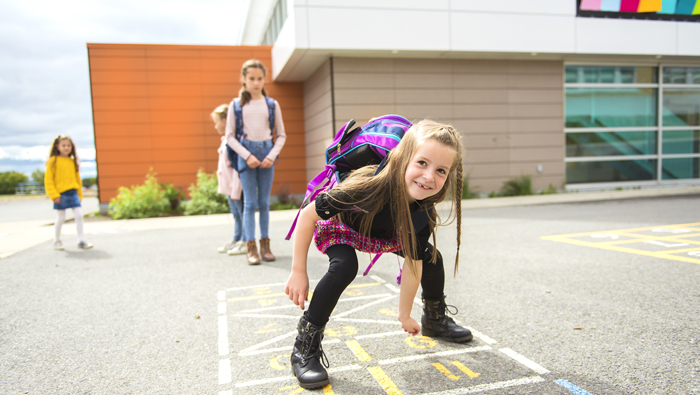School grounds play a vital role in a child’s development
It is widely acknowledged that children require time in the outdoors for their physical, mental and general well-being. However, with less open green spaces for children to play in and an increase in parental concerns over safety, today’s generation of children are leading increasingly indoor, sedentary and virtual lifestyles.
This is causing a direct impact not only on our children’s physical health and emotional well-being, but also on their social competences and connection to the natural world.
According to Parenting Science, there is no one-size-fits-all solution but overall, outdoor play provides a multitude of benefits for a child’s development:
- A reduced risk of myopia, or nearsightedness.
- Greater exposure to bright light, which enhances health and mental performance.
- Increased activity levels and greater freedom to run, jump and climb.
- Opportunities for hand-on learning about physical forces and concepts.
- Reduced stress levels, better moods and improved concentration.
- More naturally-attuned sleep rhythms.
- Enhanced opportunities to learn social skills, overcome fears, and develop a lifelong connection with nature.
Further research has continued to show that outdoor learning and play can tackle many of the issues associated with the state of modern childhood. Moreover, pupils now spend up to 25% of their time at school outside, school grounds matter substantially!
Despite these strong facts, school grounds around the nation are still often underused and undervalued.
School grounds have a profound impact on a child
How school grounds are used, or sadly in many cases – not used – and the aesthetics of the grounds both have a direct effect on how the children feel about the school and themselves. This happens because children understand school grounds as places created especially for them. In addition to this, because children read messages and meanings from their surroundings, the value placed on the grounds again, reflects on how the children feel about the school and themselves.
The value placed on the use of school grounds and their appearance has a profound impact on many factors:
- How a child feels about themselves
- How a child feels about others around them
- How a child feels about their school
- A child’s behaviour and attitude towards themselves
- A child’s behaviour and attitude towards others around them
Schools that actively work to improve their school grounds have also reported:
- Improvements in child behaviour
- Improvements in children’s attitude to learning
- Improved social interaction between children
- Increased creative learning and environmental awareness
- Increased inclusiveness for children at all ages and levels
All of these improvements are key elements to unlocking the development and learning potential of children in schools across the nation who are missing out on this opportunity.
Unlocking the potential of your existing school grounds
If you are a teacher at a primary school in Scotland and you are thinking “where would we start?” there are endless opportunities to enhance and maximise existing spaces for outdooring learning and play.
School grounds are an incredible resource!
- School grounds are accessible and safe
- They require no additional staff
- No additional transport is required
- There is no requirement for parental consent or forms
- There is no additional cost!
In addition to the above operational benefits, school grounds offer a wide range of unique opportunities and experiences for learning across all curriculum areas – all year round! Yes, it’s true!
And the benefits don’t stop there, outdoor play and learning also provides endless advantages for school staff, allowing them to be creative in their teaching by adding a new dimension to lessons that is simply not possible indoors.
Summary
Stepping out of the classroom, into the bright sunshine and outdoors will provide children at school with the freedom to move, to roam, to express themselves and to grow. Combining education with the outdoors helps children engage in their learning. In many cases, the children who do not show as much engagement inside the classroom respond positively to being outdoors and participate more actively than before.
There are many benefits of learning outdoors and we understand that school grounds play a huge role in providing this type of learning environment that children so desperately need.
Children who struggle in the classroom will flourish in an outdoor environment, as it provides a unique opportunity to learn in a different way.
School grounds can also be a great way for children to connect with the natural world. This connection with nature has shown to be important for emotional well-being, having a calming restorative effect on pupils.
Any adult would testify that these skills and characteristics are invaluable traits to own in order to live a happy, healthy life.
If you would like to find out more about making changes to your outdoor space, or
would like to book a half/full day visit with Pauline, please don’t hesitate to get in touch
on 01346 571533 or at pauline@urbangreendesign.org.
References
Gwen Dewar, Ph.D., 2019, 12 benefits of outdoor play, Parenting Science, accessed Sunday 23 August 2020, <https://www.parentingscience.com/benefits-of-outdoor-play.html

